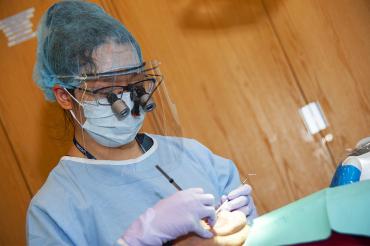Dentists at lower risk of getting COVID-19: Study

A study by researchers at U of T and other Canadian universities found that dentists were less likely than the general public to get COVID-19 (photo by Jeff Comber)
Published: November 22, 2021
Does close contact with patients put dentists at greater risk of catching COVID-19?
According to a new study by researchers at the University of Toronto and three other Canadian universities, dentists appear – perhaps counterintuitively – less likely than the general population to contract the virus.
“When we started this study in July of 2020, there was so much unknown about COVID-19,” says Michael Glogauer, a professor in U of T's Faculty of Dentistry and dentist-in-chief at the University Health Network. “There were no vaccines and it was unclear how much of a risk dentists were actually at in terms of this virus. We wanted to get a good assessment of how much risk there actually was.”
The study, published in The Journal of the American Dental Association this fall, was led by Assistant Professor Sreenath Madathil of McGill University and was co-authored by eight other researchers, including Glogauer and Professor Carlos Quiñonez at U of T's Faculty of Dentistry.
The study was based on a sample of 644 licensed dentists across Canada from July 29, 200 to Feb. 12 of this year. The researchers used an online questionnaire and self-collected oral swabs to track the incidence of COVID-19 among the study participants.
Six people reported catching COVID-19 during the study period. The incidence rate was estimated to be 1,084 per 100,000 dentists, compared to 1,864 per 100,000 people in the general public during the same period, the study says.
“I wasn’t really surprised by these results because similar data has also been published in a study of American dentists, and in Canada, we are taking even more precautions,” Quiñonez says. “What’s interesting is there appears to be a slightly higher rate of infection in European jurisdictions, so something is different, we just aren’t sure exactly what yet. What we’re trying to determine is what is the actual nature of the risk and why would we see this differentiation in different parts of the world.”
Glogauer notes that dentists take precautions to protect the public, patients and dental office staff from outbreaks.
“We have a rapid ability to upgrade PPE and have undertaken many other measures to protect all of these groups,” he says. “This study further shows the safety of dental care. The profession’s ability to adapt quickly is shown in this study and the data is there that we remain a very safe profession.”
Quiñonez agrees, citing a whole host of reasons for the relatively low infection rate observed in this study, including: personal protective equipment, increased awareness and the fact that dentists may be exercising extra caution outside of work.
“We don’t have all the explanations other than to say that dentists aren’t getting COVID-19,” he says. “This is a quick peek under the hood meaning there is a lot going on. We are adding to the evidence base here in Canada which is suggesting that COVID-19 infection risk is potentially not high or is at least controlled by what’s going on in dental offices, which is good news.”
Glogauer says this is a good time to ask if the current measures are appropriate or overly stringent.
“We can use the results as a starting point to determine what measures are actually necessary to continue to ensure the safety of the public, patients, office staff and dentists,” he says.
This study was supported by the Canadian Institutes of Health Research and the COVID-19 Immunity Task Force, among others.



